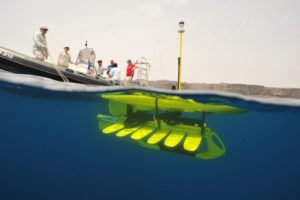
The BBC reports that UK agencies purchased an ocean-going drone from American company Liquid Robotics to patrol the 322,000-square-mile no-fishing zone around the island group, using transmitted data via satellite to enforce regulations. The Pitcairn provides a stable ecosystem to more than 1,200 species of marine mammals, fish and birds as well as “the world’s deepest and most well-developed coral reef.”
Liquid Robotics describes the Wave Glider SV3 as “the world’s first hybrid wave and solar propelled unmanned ocean robot.” The UAV is capable of real-time processing of large data packets and offers a “flexible power and storage system designed for power hungry sensors. The company recently announced that the total number of active Wave Glider drones have traveled 1 million nautical miles, achieving what company officials say is a Guinness World Record for the “longest journey by an autonomous, unmanned surface vehicle on the planet.”
Police worldwide as well as other organizations are increasingly using UAV technology to nab poachers and other wildlife law-breakers.
In South Africa, the Directorate for Priority Crime Investigation is working with state-owned tech firm Denel Dynamics on a UAV solution to battle rhino poachers in Kruger National Park. Last year, the agency arrested 317 alleged poachers and confiscated 39 horns. Between 2001-12, an estimated 949 of the endangered rhinos were killed. Officials say rhino-horn powder – believed by the uneducated to have medicinal properties, can fetch amounts up to $82,000 per kilogram.
In 2014, EYE Remote Solutions led an anti-poaching UAV project in a rhino habitat in South Africa. The company worked pro-bono and was supported by a local NGO. That same year, Sekol, a Southern Australian fishing organization, demonstrated how drones can identify schools of tuna, pinpointing both their size and location and the group says drone monitoring could uncover potential tuna poachers as well.
Interesting Fact: According to Wikipedia – “The [Pitcairn] islands are inhabited by the descendants of the Bounty mutineers and the Tahitians (or Polynesians) who accompanied them, an event retold in numerous books and 
Jason is a longstanding contributor to DroneLife with an avid interest in all things tech. He focuses on anti-drone technologies and the public safety sector; police, fire, and search and rescue.
Beginning his career as a journalist in 1996, Jason has since written and edited thousands of engaging news articles, blog posts, press releases and online content.
Email Jason
TWITTER:@JasonPReagan
Subscribe to DroneLife here.